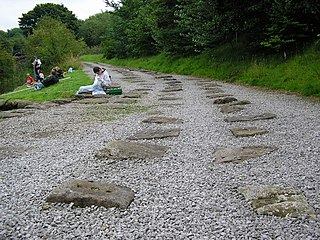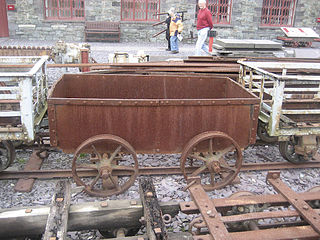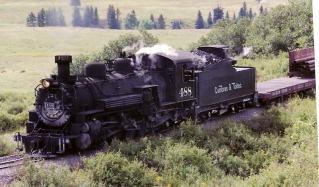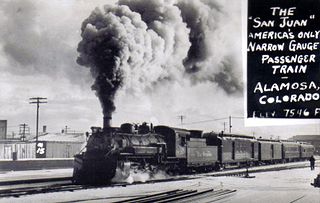
The Denver & Rio Grande Western Railroad, often shortened to Rio Grande, D&RG or D&RGW, formerly the Denver & Rio Grande Railroad, was an American Class I railroad company. The railroad started as a 3 ft narrow-gauge line running south from Denver, Colorado, in 1870. It served mainly as a transcontinental bridge line between Denver, and Salt Lake City, Utah. The Rio Grande was also a major origin of coal and mineral traffic.

Fremont Pass is a 11,318-foot (3,450 m) mountain pass in central Colorado, in the Rocky Mountains of the western United States.

A railway zig zag or switchback, is a method of climbing steep gradients with minimal need for tunnels and heavy earthworks. For a short distance, the direction of travel is reversed, before the original direction is resumed. Not all switchbacks come in pairs, in which case the train may need to travel backwards for a considerable distance.

A horseshoe curve is a class of climbing curve in a roadbed which reverses turn direction (inflection) twice on either side of a single tight curve that varies through an angle of about 180 degrees or more.

The Peak Forest Tramway was an early horse- and gravity-powered industrial railway system in Derbyshire, England. Opened for trade on 31 August 1796, it remained in operation until the 1920s. Much of the route and the structures associated with the line remain. The western section of the line is now the route of the Peak Forest Tramway Trail.

The Durango and Silverton Narrow Gauge Railroad, often abbreviated as the D&SNG, is a 3 ft (914 mm) narrow-gauge heritage railroad that operates on 45.2 mi (72.7 km) of track between Durango and Silverton, in the U.S. state of Colorado. The railway is a federally-designated National Historic Landmark and was also designated by the American Society of Civil Engineers as a National Historic Civil Engineering Landmark in 1968.

The Rio Grande Southern Railroad was a 3 ft (914 mm) narrow-gauge railroad which ran in the southwestern region of the US state of Colorado, from the towns of Durango to Ridgway, routed via Lizard Head Pass. Built by Russian immigrant and Colorado toll road builder Otto Mears, the RGS operated from 1891 through 1951 and was built with the intent to transport immense amounts of silver mineral traffic that were being produced by the mining communities of Rico and Telluride. On both ends of the railroad, there were interchanges with The Denver and Rio Grande Railroad, which would ship the traffic the RGS hauled elsewhere like the San Juan Smelter in Durango.

The Southern San Luis Valley Railroad is a fallen flag shortline railroad that was located in Southern Colorado. Best known in its final years of operation, it served a connection with the Denver and Rio Grande Western Railroad at Blanca, Colorado. The diminutive railroad in its final form was approximately 1.53 miles (2.46 km) in length. During its life freight traffic included farm produce, fertilizer and volcanic scoria. The railroad, as it was originally built, was 31 miles (50 km) long and besides freight it operated passenger service between Blanca and Jaroso, Colorado, until 1946. The railroad formally ceased all operations December 31, 1996.

The D&RG Narrow Gauge Trestle, also known as the Cimarron Canyon trestle, is a narrow-gauge railroad deck truss bridge crossing the Cimarron River near Cimarron, Colorado. Located within the Curecanti National Recreation Area, the trestle is the last remaining railroad bridge along the Denver & Rio Grande Railroad's Black Canyon route, a narrow-gauge passenger and freight line that traversed the famous Black Canyon of the Gunnison between 1882 and the 1940s.

The Nantlle Railway was a Welsh narrow gauge railway. It was built to carry slate from several slate quarries across the Nantlle Valley to the harbour at Caernarfon for export by sea. The line provided a passenger service between Caernarfon and Talysarn from 1856 to 1865. It was the first public railway to be operated in North Wales.

The Silverton Railroad, now defunct, was an American 3 ft narrow gauge railroad constructed between Silverton, Colorado and mining districts near Red Mountain Pass, Colorado.

The Denver and Rio Grande Western K-36 is a class of ten 3 ft narrow gauge 2-8-2 "Mikado" type steam locomotives built for the Denver and Rio Grande Western Railroad (D&RGW) by Baldwin Locomotive Works. They were shipped to the Rio Grande in 1925 and were first used along the Monarch Branch and Marshall Pass, but were later sent to the Third Division out of Alamosa. Of the original ten, four are owned by the Durango and Silverton Narrow Gauge Railroad (D&SNG) and five by the Cumbres and Toltec Scenic Railroad (C&TSRR). Number 485 fell into the turntable pit at Salida and was scrapped in Pueblo in 1955, with many parts being saved.

The Denver and Rio Grande Western K-27 is a class of 3 ft narrow gauge 2-8-2 "Mikado" type steam locomotives built for the Denver and Rio Grande Railroad by the Baldwin Locomotive Works in 1903. Known by their nickname "Mudhens," they were the first and the most numerous of the four K classes of Rio Grande narrow gauge engines to be built. Of the original fleet of 15 locomotives, two survive to this day and operate on heritage railways in the United States. No. 463 is operational on the Cumbres and Toltec Scenic Railroad (C&TSRR) in Chama, New Mexico and No. 464 is operational on the Huckleberry Railroad in Genesee Township, Michigan.

The Leighton Buzzard Light Railway (LBLR) is a light railway in Leighton Buzzard in Bedfordshire, England. It operates on 2 ft narrow-gauge track and is just under 3 miles (4.8 km) long. The line was built after the First World War to serve sand quarries north of the town. In the late 1960s the quarries switched to road transport and the railway was taken over by volunteers, who now run the line as a heritage railway.

The Utah Division of the former Denver & Rio Grande Western Railroad (D&RGW) is a rail line that connects Grand Junction, Colorado and Salt Lake City, Utah in the Western United States. It is now incorporated into the Union Pacific Railroad (UP) system as part of the Central Corridor. The modern Union Pacific has split the line into two subdivisions for operational purposes, the Green River Subdivision between Grand Junction and Helper, Utah and the Provo Subdivision from Helper to Salt Lake City. Daily passenger service is provided by Amtrak's California Zephyr; the BNSF Railway and Utah Railway have trackage rights over the line.

The Denver and Rio Grande Western K-37 is a class of 2-8-2 "Mikado" type narrow-gauge steam locomotives built for the Denver and Rio Grande Western Railroad. They were all new steam locomotives built in the D&RGW Burnham Shops as a cheaper option to new Baldwin K-36s. The tenders were originally converted from standard gauge tenders
The Chili Line, officially known as the Santa Fe Branch, was a 3 ft narrow-gauge branch of the Denver and Rio Grande Western Railroad (D&RGW). It ran 125.6 miles (202.1 km) from Antonito, Colorado, to Santa Fe, New Mexico. The Denver and Rio Grande Railway (D&RG) began construction of the line in 1880 and completed the line from Antonito to Española, New Mexico, but could not build any further because of an agreement with the Atchison, Topeka and Santa Fe Railroad (AT&SF). The Texas, Santa Fe and Northern Railroad was incorporated to complete the line, and the line between Española and Santa Fe opened in 1886 and was transferred to the Denver and Rio Grande shortly thereafter. The D&RGW closed the Chili Line in 1941 because of competition from road transportation, and the line was abandoned shortly thereafter.

The San Juan Express was a narrow gauge train that ran on the 3 feet (0.91 m) Denver & Rio Grande Western Railroad (D&RGW) route from Durango, Colorado via Chama, New Mexico; Cumbres Pass; and Antonito, Colorado to Alamosa, Colorado. The train ran from February 11, 1937 until January 31, 1951 as train numbers 115 and 116, though towards the end of the passenger service it took on the number 215 and 216.

The Alamosa–Durango line or San Juan extension was a railroad line built by the Denver and Rio Grande Western Railroad, following the border between the U.S. states of Colorado and New Mexico, in the Rocky Mountains. The line was originally built as a 3 ft narrow-gauge line between Alamosa, Colorado, and Durango, Colorado. Portions of the route survive to this day: the now standard-gauged segment from Alamosa to Antonito, Colorado, and a narrow-gauge portion from Antonito to Chama, New Mexico.

Cerro Summit is a mountain pass in the State of Colorado, located about 14 miles east of Montrose, Colorado. It divides the watershed of the Cimmaron River to the east and the Uncompahgre River to the west, both of which eventually flow into the Gunnison River.



















